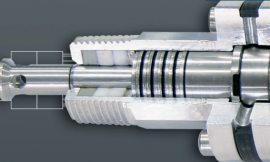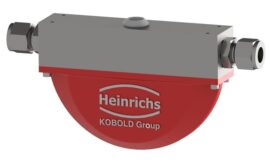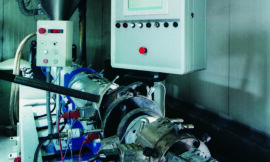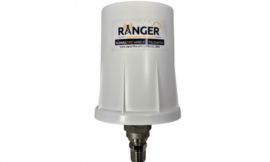![]()
With 2.4 million miles of distribution and transmission pipelines across the United States, natural gas stakeholders have a heavy burden of understanding the flow rates in their networks.
Within that system, there are more than 17,400 points of transfer, including those between the producer and the pipeline company or the pipeline company to local distribution providers and end-users (commercial, industrial, residential, and energy generation) – the latter of which represent the majority of these transfer points.

Gas Measurement
In order to measure the flow of gas throughout the distribution network, gas metering stations are located at strategic locations to provide information on the quantity and composition of the gas within the pipeline.
The gas meters stations determine the energy content in the gas, compounds mixed into the gas (e.g. hydrogen sulphide), water content, and flow rate. Volumetric measurement is, perhaps, the most important functions of the gas metering station. Without it, energy content could not be determined locally and therefore the financial value of the gas would be in question.
Flow measurement technologies typically used on gas metering stations include ultrasonic, orifice, and turbine flow meters, depending upon the requirements of the producer or pipeline company. The accuracy of these meters is a principal concern to those with fiscal interest in the transfer of natural gas.
With annual consumption of more than 25 trillion cubic feet[1], the smallest miscalculation due to a systematic error in the meter or uncertainty in the calculation of actual flow rate will have a significant impact on stakeholders throughout the supply chain – equally from a revenue and expense perspective. The potential enormity of the delta between the profit and loss makes it imperative that the most accurate flow measurement technology is used at critical junctures in the distribution network.
Metering Technology
Among all the commonly used metering technologies available in the market, turbine meters are inherently better suited for measuring and monitoring pipeline flows than competing technologies. While orifice meters are also very accurate, they’re typically used for line sizes between 4” to 12”, and are often found in the transmission portion of the network; whereas, turbines are typically found in the distribution portion of the network, which utilizes small diameter pipes ranging in size from ½” to 3”.
Turbine meters are ideal for pipeline monitoring and metering requirements, as well as a variety of other oil field, industrial, and commercial environments. Industrial-strength turbine meters consist of a stainless steel rotor, mounted on a shaft, that spins within a length of pipe. Gases flowing through it spin the rotor, with higher flows leading to higher speeds. As the rotor spins, a magnetic sensor in the housing picks up its speed by counting the rate at which rotor blades pass it.
Turbine meters can also be custom designed to fit their applications, and use a variety of materials depending upon the temperature, pressure, flow rate, and flow medium requirements. Materials are selected for durability, corrosion resistance, piping requirements, and value.
In addition, gas turbine meters can maintain standard accuracy across the flow range of no less than +/- 1.0%, repeatability of +/- 0.1%, and linearity of +/- 1.0 % (density dependent). Depending upon its location and seasons, gas turbine meters can work under operating conditions of -450°F to +800°F. The ACFM range of turbine meters depends upon the line size, but generally is between 0.5 to 12,000 ACFM.
Turbine meters are commonly available from most manufacturers and distributors. However, not all of them are created with precision manufacturing and verifiable calibrations. Partnering with a trusted turbine meter supplier is of paramount importance because the quality, reliability, accuracy, and longevity of the metering solution require a commitment to full-service design, manufacture, calibration, and ongoing service.
As mentioned previously, faulty or inaccurate measurement can have enormous financial implications. Therefore, it’s of the upmost importance that a gas utility company insists upon receiving independent calibration for each meter. With in-house and third-party verification, manufacturers of high-quality meters can provide a unique K-factor[2] pertaining to each meter.
Effective Monitoring
An accurate meter must be accompanied with a monitor to accurately compute and display corrected volume of gas within the distribution network. Monitors must be able to receive temperature and pressure information in order to properly calculate the effect of gas compressibility on computed volumes or masses.
Real-time correction for pressure and temperature has an immediate impact on the accuracy of the flow measurement system and must be considered when variations in gas temperatures and pressures are expected and cannot be regulated.
Conclusion
The use of a precise flow measurement system, like a turbine meter paired with a compensated flow monitor, has quantifiably positive implications throughout the distribution portion of the pipeline network. With downward pressure on natural gas prices, pipeline companies and utilities need assurances that their charging their end users correctly, while also ensuring the performance and safety of their systems.
Turbines, Inc. and Turbines Research & Development serve a range of industries and applications, from oil and gas, to cryogenic liquids, to custody transfer. Turbines, Inc.’s high-quality products, fast and reliable order fulfillment, and commitment to customer and technical support, have made them an industry leader in reliable flow metering.
[1] http://www.eia.gov/totalenergy/data/monthly/pdf/sec4_2.pdf
[2] The K-factor is an expression of the number of output pulses recorded by the flow meter per engineering unit of volume flow passing through the meter. A unique K-factor is documented by means of NIST-traceable factory calibration.
Click here for more informationClick here for related articles and newsSearch for gas turbine meters manufacturers in our equipment guide
Sign up for Flow Control and Measurement E-Updates
Turbines Inc. designs and manufactures competitively priced, accurate and reliable liquid and cryogenic turbine flow meters, electronic monitors, accessories, and replacement parts, with measured impeccable performance and reliability. Founded in 1975, we have earned an industry-leading reputation for our outstanding customer service. Our flow metering …
Source of Article



